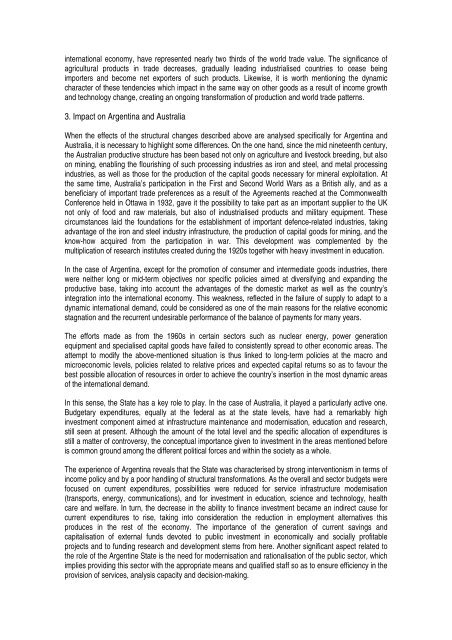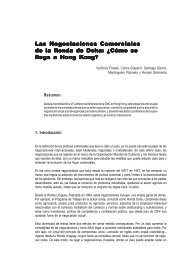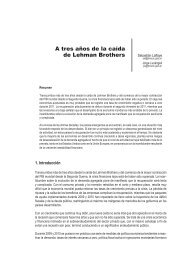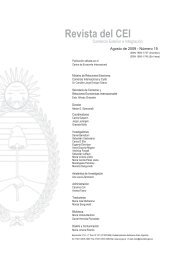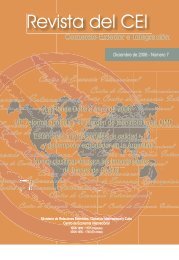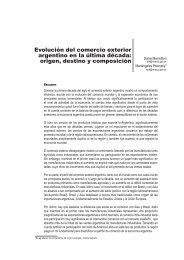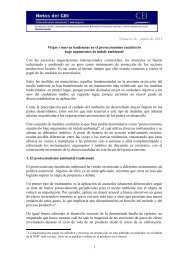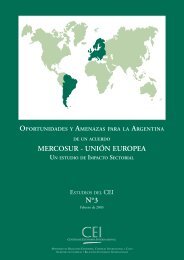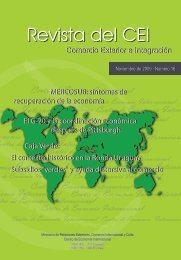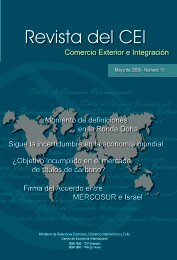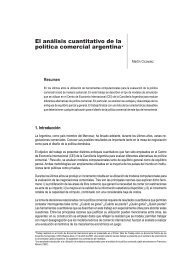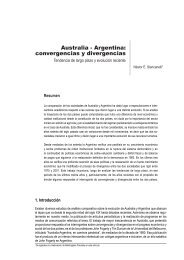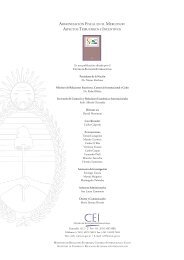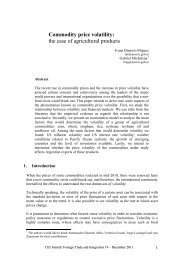enabled a symmetrical growth in the production and tra<strong>de</strong> of both types of products, also resulting in theirrelative price stability.Both Australia and the Argentine Republic took part in this international division of labour, welcoming largecontingents of European workers <strong>de</strong>voted to the <strong>de</strong>velopment of production and receiving a significantvolume of loans and investment, mainly from the United Kingdom, aimed at the expansion of the railwaynetwork and public utilities, as well as of tra<strong>de</strong>, finances, and foreign-tra<strong>de</strong>-related primary sectoractivities.Immigration incentives targeted at Anglo-Saxons in the case of Australia and Europeans in that ofArgentina, constituted the necessary domestic conditions for population growth in the respective territoriesand for the exploitation and commercialisation of products <strong>de</strong>rived from natural resources, whichconstituted an important source of earnings and capitalisation, bearing in mind the favourable price ratiothose products enjoyed until the 1930s. Public investment in infrastructure, largely supported by externalfunding, together with the establishment of a system of public, free and compulsory education, thepromotion of research institutes, and the expansion of health care services laid the foundations for theintegration of the immigrants to their host countries and for their full participation in economic activity.2. Structural Changes to the Mo<strong><strong>de</strong>l</strong>The <strong>de</strong>scribed parallelism is altered after the Great Depression, although the transformation stems from apre-existent background. The most noteworthy aspects of the changes produced in international economicrelations, sharply reflected in the 1930 crisis and which will have an impact on the participation of suchcountries as Argentina and Australia in international tra<strong>de</strong>, are connected with the emergence ofautonomous and <strong>de</strong>mand-induced trends and with the transformation of world power.The lessening importance of the United Kingdom and the new supremacy of the United States affect theinternational division of labour. In contrast to what happened with England and other European countries,the United States constitutes a more autarchic economy, as a major exporter of agricultural products, withan import coefficient slightly higher than 10% of GDP as compared to 36%, the figure for the UnitedKingdom at the end of the nineteenth century.On the other hand, the increase in income in industrialised countries produces autonomous ten<strong>de</strong>ncies ofdirect correlation between said increase and the <strong>de</strong>mand for manufactured goods, as well as an inversecorrelation with the <strong>de</strong>mand for raw materials, food and processed agricultural products. This means that,as income increases, the participation of food, raw materials and processed products in total expenditure<strong>de</strong>creases. Additionally, technological advances, through the improvement of the technical coefficients ofexploitation of raw materials for industrial purposes, accentuate the effects of autonomous ten<strong>de</strong>ncies inthe long run.The appearance of ten<strong>de</strong>ncies induced by protectionism which, in the long run, will affect the tra<strong>de</strong> ofproducts facing a less dynamic <strong>de</strong>mand, represents another important element, ever more noticeablesince the crisis of the 1930s. There are various causes un<strong>de</strong>rlying the protectionist phenomenon, motiveswhose character is related to either economics (implementation of counter-cyclical policies), labour(maintenance of productive factors occupation), <strong>de</strong>fence (securing supplies), ecology (preservation ofnatural resources), or income redistribution (from the industrial to the agricultural sector), and whosecomplexity and impact on the <strong>de</strong>velopment of the most industrialised societies explain their persistenceand inflexibility.There is a noteworthy key difference between the impact of the spontaneous and induced ten<strong>de</strong>nciesmentioned above. The former affect the rate of production of primary and industrial products as incomegrows. The latter cause an increase in the domestic production of the first category of products, reducingthe dynamism of the corresponding world tra<strong>de</strong>. As a whole, they lead to a substantial change in theproductive and <strong>de</strong>mand structure in industrialised countries, which until recent years, before theformidable economic expansion of China, India and other Asiatic countries impacted heavily on the
international economy, have represented nearly two thirds of the world tra<strong>de</strong> value. The significance ofagricultural products in tra<strong>de</strong> <strong>de</strong>creases, gradually leading industrialised countries to cease beingimporters and become net exporters of such products. Likewise, it is worth mentioning the dynamiccharacter of these ten<strong>de</strong>ncies which impact in the same way on other goods as a result of income growthand technology change, creating an ongoing transformation of production and world tra<strong>de</strong> patterns.3. Impact on Argentina and AustraliaWhen the effects of the structural changes <strong>de</strong>scribed above are analysed specifically for Argentina andAustralia, it is necessary to highlight some differences. On the one hand, since the mid nineteenth century,the Australian productive structure has been based not only on agriculture and livestock breeding, but alsoon mining, enabling the flourishing of such processing industries as iron and steel, and metal processingindustries, as well as those for the production of the capital goods necessary for mineral exploitation. Atthe same time, Australia’s participation in the First and Second World Wars as a British ally, and as abeneficiary of important tra<strong>de</strong> preferences as a result of the Agreements reached at the CommonwealthConference held in Ottawa in 1932, gave it the possibility to take part as an important supplier to the UKnot only of food and raw materials, but also of industrialised products and military equipment. Thesecircumstances laid the foundations for the establishment of important <strong>de</strong>fence-related industries, takingadvantage of the iron and steel industry infrastructure, the production of capital goods for mining, and theknow-how acquired from the participation in war. This <strong>de</strong>velopment was complemented by themultiplication of research institutes created during the 1920s together with heavy investment in education.In the case of Argentina, except for the promotion of consumer and intermediate goods industries, therewere neither long or mid-term objectives nor specific policies aimed at diversifying and expanding theproductive base, taking into account the advantages of the domestic market as well as the country’sintegration into the international economy. This weakness, reflected in the failure of supply to adapt to adynamic international <strong>de</strong>mand, could be consi<strong>de</strong>red as one of the main reasons for the relative economicstagnation and the recurrent un<strong>de</strong>sirable performance of the balance of payments for many years.The efforts ma<strong>de</strong> as from the 1960s in certain sectors such as nuclear energy, power generationequipment and specialised capital goods have failed to consistently spread to other economic areas. Theattempt to modify the above-mentioned situation is thus linked to long-term policies at the macro andmicroeconomic levels, policies related to relative prices and expected capital returns so as to favour thebest possible allocation of resources in or<strong>de</strong>r to achieve the country’s insertion in the most dynamic areasof the international <strong>de</strong>mand.In this sense, the State has a key role to play. In the case of Australia, it played a particularly active one.Budgetary expenditures, equally at the fe<strong>de</strong>ral as at the state levels, have had a remarkably highinvestment component aimed at infrastructure maintenance and mo<strong>de</strong>rnisation, education and research,still seen at present. Although the amount of the total level and the specific allocation of expenditures isstill a matter of controversy, the conceptual importance given to investment in the areas mentioned beforeis common ground among the different political forces and within the society as a whole.The experience of Argentina reveals that the State was characterised by strong interventionism in terms ofincome policy and by a poor handling of structural transformations. As the overall and sector budgets werefocused on current expenditures, possibilities were reduced for service infrastructure mo<strong>de</strong>rnisation(transports, energy, communications), and for investment in education, science and technology, healthcare and welfare. In turn, the <strong>de</strong>crease in the ability to finance investment became an indirect cause forcurrent expenditures to rise, taking into consi<strong>de</strong>ration the reduction in employment alternatives thisproduces in the rest of the economy. The importance of the generation of current savings andcapitalisation of external funds <strong>de</strong>voted to public investment in economically and socially profitableprojects and to funding research and <strong>de</strong>velopment stems from here. Another significant aspect related tothe role of the Argentine State is the need for mo<strong>de</strong>rnisation and rationalisation of the public sector, whichimplies providing this sector with the appropriate means and qualified staff so as to ensure efficiency in theprovision of services, analysis capacity and <strong>de</strong>cision-making.
- Page 1 and 2:
Revista del CEIComercio Exterior e
- Page 3:
SUMARIOCOYUNTURA COMERCIALEstructur
- Page 7 and 8:
PresentaciónLa sección de coyuntu
- Page 13 and 14:
G r á f i c o 3Diversificación de
- Page 15 and 16:
Las exportaciones de productos prim
- Page 17 and 18:
Relacionado con la evolución que v
- Page 19 and 20:
Vinculado al fuerte crecimiento que
- Page 21 and 22:
Este efecto fue revertido principal
- Page 23 and 24:
Aun así, merecen destacarse al men
- Page 25 and 26:
Cuadro A 1Evolución del saldo de b
- Page 28 and 29:
Cuadro A 4Exportaciones e índice d
- Page 30 and 31:
Cuadro A 6Saldo de balanza comercia
- Page 32 and 33:
las exportaciones en concepto de vi
- Page 34 and 35:
G r á f i c o 3Valor y cambio abso
- Page 36 and 37:
como lo son Egipto, Nigeria, Venezu
- Page 38 and 39:
G r á f i c o 2Crecimiento de las
- Page 40 and 41:
El total exportado también se encu
- Page 42 and 43:
Del Cuadro 1 se desprende una asoci
- Page 44 and 45:
En el primer semestre del año, el
- Page 46 and 47:
Vehículos de navegación aérea, m
- Page 48 and 49:
Unidos. En todos los casos menciona
- Page 50 and 51:
BibliografíaCastagnino, T. (2006).
- Page 52 and 53:
Cuadro A 2G R Á F I C O 1:Exportac
- Page 54 and 55:
Cuadro A 4Exportaciones e índice d
- Page 56 and 57:
Cuadro A 6Saldo de balanza comercia
- Page 58 and 59:
las exportaciones en concepto de vi
- Page 60 and 61:
G r á f i c o 3Valor y cambio abso
- Page 62 and 63:
Se mantiene eldinamismo del BloqueH
- Page 64 and 65:
vez como miembro pleno, en junio tu
- Page 66 and 67:
en el primer semestre del año.Las
- Page 68 and 69:
septiembre del año pasado un baja
- Page 70 and 71:
considera que al cierre del año la
- Page 72 and 73:
dólares norteamericanos, asciende
- Page 74 and 75:
Ambición y equilibrioen la Ronda D
- Page 76 and 77:
3. Resultados mínimos de las conce
- Page 78 and 79:
La aplicación de la propuesta menc
- Page 80 and 81:
4. La ambición y el equilibrio nec
- Page 82 and 83:
El ingreso deVenezuela al Mercosur:
- Page 84 and 85:
A 2006 la estructura arancelaria vi
- Page 86 and 87:
En principio la Argentina participa
- Page 88 and 89:
hubieron otros donde la participaci
- Page 90 and 91:
se puede establecer, según datos d
- Page 92 and 93:
La otra metodología que se utiliza
- Page 94 and 95:
Asimismo, reconoce que la prestaci
- Page 96 and 97:
problema debido a que en el Anexo D
- Page 98 and 99:
Según lo observado en los procesos
- Page 100 and 101:
Trade Facilitation:Definitions, WTO
- Page 102 and 103:
se puede establecer, según datos d
- Page 104 and 105: La otra metodología que se utiliza
- Page 106 and 107: Asimismo, reconoce que la prestaci
- Page 108 and 109: problema debido a que en el Anexo D
- Page 110 and 111: Según lo observado en los procesos
- Page 112 and 113: Australia - Argentina:convergencias
- Page 114 and 115: Artículosde 2002 en adelante, por
- Page 116 and 117: Artículosaustraliano), para la rat
- Page 118 and 119: Artículosimportantes inversiones y
- Page 120 and 121: Artículossociales de carácter mod
- Page 122 and 123: Artículospagos de la Administraci
- Page 124 and 125: Artículosmayor libertad de acción
- Page 126 and 127: ArtículosLa disminución del peso
- Page 128 and 129: Artículospor 6.490 millones de dó
- Page 130 and 131: ArtículosLos datos anteriores evid
- Page 132 and 133: ArtículosAustralia a Canberra en 1
- Page 134 and 135: Artículossentaron el 25,0% del tot
- Page 136 and 137: ArtículosBibliografíaAustralian B
- Page 138 and 139: El análisis cuantitativo de lapol
- Page 140 and 141: ArtículosSimulacionesLa metodolog
- Page 142 and 143: Artículoscomo así también insumo
- Page 144 and 145: Artículosdiante la matriz inversa
- Page 146 and 147: ArtículosLas estimaciones realizad
- Page 148 and 149: SummaryAustralia - Argentina:Conver
- Page 150 and 151: evealed by growing political and cu
- Page 152 and 153: Governor-General proposing the pers
- Page 156 and 157: 3. Recent EvolutionThe information,
- Page 158 and 159: science and technology. The last es
- Page 160 and 161: Table 5Employment and Unemploymentp
- Page 162 and 163: Table 7High Human Development Index
- Page 164 and 165: It can be stated that Australia has
- Page 166 and 167: 3. Balance of Payments and Foreign
- Page 168 and 169: end of 2006. For the very first tim
- Page 170 and 171: Budget surplus has a counter-cyclic
- Page 172 and 173: plantations, food industries, cold
- Page 174 and 175: The One Thousand Faces ofAgricultur
- Page 176 and 177: A fines de la década de los 50, cu
- Page 178 and 179: estratégicos que efectúan los pa
- Page 180 and 181: subsidios (es más, sólo el 5 por
- Page 182 and 183: de exportar aeronaves y de no afron
- Page 184 and 185: deberíamos suponer que habría una
- Page 186 and 187: tienen jerarquía de tratado intern
- Page 188 and 189: Con el establecimiento de la OMC se
- Page 190 and 191: 3. Para completar el tercer aspecto
- Page 192 and 193: 5 Anexo
- Page 194 and 195: AnexoPIB a precios y tipos de cambi
- Page 196 and 197: AnexoSaldo de la Cuenta Corrienteen
- Page 198 and 199: AnexoTasas de Desempleopromedio anu
- Page 200 and 201: AnexoTasas de inflación (Precios M


